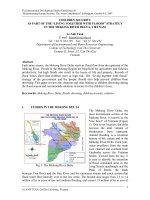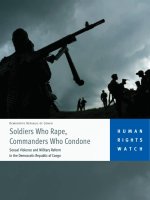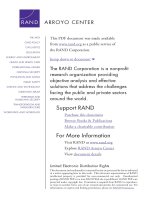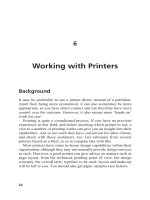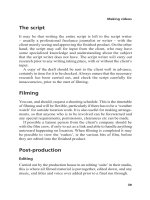Chinese military strategy in the third indochina war the last maoist war
Bạn đang xem bản rút gọn của tài liệu. Xem và tải ngay bản đầy đủ của tài liệu tại đây (1.86 MB, 257 trang )
Tai Lieu Chat Luong
Chinese Military Strategy in the
Third Indochina War
This book examines the Sino-Vietnamese conflicts of the late 1970s and 1980s,
attempting to understand them as strategic, operational, and tactical events.
The Sino-Vietnamese War was the Third Indochina War, and contemporary
Southeast Asia cannot be properly understood unless we acknowledge that the
Vietnamese fought three, not two wars to establish their current role in the
region. The war was not about the Sino-Vietnamese border, as frequently
claimed, but about China’s support for its Cambodian ally, the Khmer Rouge,
and this book addresses both US and ASEAN involvement in the effort to
support the regime. Although the Chinese completed their troop withdrawal in
March 1979, they retained their strategic goal of driving Vietnam out of Cambodia at least until 1988, but it was evident by 1984–85 that the Chinese Army,
held back by the drag of its “Maoist” organization, doctrine, equipment, and personnel, was not an effective instrument of coercion.
Chinese Military Strategy in the Third Indochina War will be of great interest
to students of Southeast Asian politics, Chinese security, and military and strategic studies in general.
Edward C. O’Dowd holds the Major General Matthew C. Horner Chair of
Military Theory at the Marine Corps University, Quantico.
Asian security studies
Series Editors: Sumit Ganguly
Indiana University, Bloomington
and
Andrew Scobell
US Army War College
Few regions of the world are fraught with as many security questions as Asia.
Within this region it is possible to study great power rivalries, irredentist conflicts, nuclear and ballistic missile proliferation, secessionist movements,
ethnoreligious conflicts and inter-state wars. This new book series will publish
the best possible scholarship on the security issues affecting the region, and will
include detailed empirical studies, theoretically oriented case studies and policyrelevant analyses as well as more general works.
China and International Institutions
Alternate paths to global power
Marc Lanteigne
China’s Rising Sea Power
The PLA Navy’s submarine challenge
Peter Howarth
If China Attacks Taiwan
Military strategy, politics and economics
Edited by Steve Tsang
Chinese Civil–Military Relations
The transformation of the People’s Liberation Army
Edited by Nan Li
The Chinese Army Today
Tradition and transformation for the 21st century
Dennis J. Blasko
Taiwan’s Security
History and prospects
Bernard D. Cole
Religion and Conflict in South and Southeast Asia
Disrupting violence
Edited by Linell E. Cady and Sheldon W. Simon
Political Islam and Violence in Indonesia
Zachary Abuza
US–Indian Strategic Cooperation into the 21st Century
More than words
Edited by Sumit Ganguly, Brian Shoup and Andrew Scobell
India, Pakistan and the Secret Jihad
The covert war in Kashmir, 1947–2004
Praveen Swami
Chinese Military Strategy in the Third Indochina War
The last Maoist war
Edward C. O’Dowd
Chinese Strategic Culture and Foreign Policy Decision-making
Confucianism, leadership and war
Huiyun Feng
Chinese Military Strategy in
the Third Indochina War
The last Maoist war
Edward C. O’Dowd
First published 2007
by Routledge
2 Park Square, Milton Park, Abingdon, Oxon OX14 4RN
Simultaneously published in the USA and Canada
by Routledge
270 Madison Ave, New York, NY 10016
Routledge is an imprint of the Taylor & Francis Group, an informa business
This edition published in the Taylor & Francis e-Library, 2007.
“To purchase your own copy of this or any of Taylor & Francis or Routledge’s
collection of thousands of eBooks please go to www.eBookstore.tandf.co.uk.”
© 2007 Edward C. O’Dowd
All rights reserved. No part of this book may be reprinted or reproduced or
utilized in any form or by any electronic, mechanical, or other means, now
known or hereafter invented, including photocopying and recording, or in
any information storage or retrieval system, without permission in writing
from the publishers.
British Library Cataloguing in Publication Data
A catalogue record for this book is available from the British Library
Library of Congress Cataloging in Publication Data
A catalog record for this book has been requested
ISBN 0-203-08896-4 Master e-book ISBN
ISBN10: 0-415-41427-X (hbk)
ISBN10: 0-203-08896-4 (ebk)
ISBN13: 978-0-415-41427-2 (hbk)
ISBN13: 978-0-203-08896-8 (ebk)
In Memoriam
Denis Twitchett (1925–2006)
Scholar, Mentor, Friend
Contents
List of maps
Acknowledgments
ix
x
PART I
Introduction
1 Introduction
1
3
PART II
Background
2 The Chinese political work system
11
13
PART III
Narrative
31
3 Hanoi and Beijing on the road to war
33
4 The 1979 campaign
45
5 The Battle of Lang Son, February–March 1979
74
6 Artillery diplomacy: waiting for the “second lesson”
89
PART IV
Explorations
7 Crisis in command: the cadre system under stress in the
Guangzhou Military Region
109
111
x
Contents
8 Political work in the 1979 campaign
122
9 Politics versus firepower: the paradox of Maoist tactics
143
PART V
Conclusion
157
10 Conclusion: the legacy of an “incredible, shrinking war”
159
Appendix 1: principles of the political work system
Appendix 2: principal duties of the political commissar
Notes
Bibliography
Index
167
169
170
205
229
Maps
1
2
3
4
5
6
7
8
9
10
11
12
13
14
15
16
The China–Vietnam border
The main attacks (1979)
Symbols
Ground order of battle comparison: 1979
Military regions and the Cau River defensive line
The Lang Son Front (1979)
The Cao Bang Front (1979)
The Lao Cai Front (1979)
The Battle of Lang Son (1979)
The northern approach to Lang Son: the Dong Dang–Tham
Mo area (1979)
The northern approach to Lang Son: the Tham Lung–Khau
Ma Son area (1979)
The southern approach to Lang Son: the Chi Ma–Loc Binh
area (1979)
The southern approach to Lang Son: the Loc Binh–Lang Son
area (1979)
The Fakashan area (1981)
The Laoshan area (1984–86)
Artillery diplomacy: major attacks (1980–87)
47
47
48
48
50
56
58
61
75
80
81
85
86
94
99
106
Acknowledgments
I would like to thank all the scholars and friends who have helped me complete
this study. I owe special thanks to Professor Susan Naquin for her guidance and
insight. Without her endless patience, this project could never have been completed. I wish to thank Professors Ellis Joffe, Tom Christiansen, Sheldon Garon,
and Paul Miles for their contributions to this project. I also thank Professors
Arthur Waldron and Denis Twitchett for their encouragement and support.
Professor Liz Lunbeck and Dean David Redman deserve special thanks for
giving me a second chance to complete the dissertation upon which this study is
based. John F. Corbett, Jr has generously shared his materials and knowledge
about this topic. His friendship and support have been crucial to this project.
Professor Paula Baker has been unceasingly helpful, and I am grateful for her
comments and encouragement.
Merle L. Pribbenow made important contributions by sharing his library and
translations of Vietnamese military publications. Keith, who does not need to be
further identified, deserves special thanks for providing assistance, translations,
and help with Chinese language material. Weber Wung also deserves special
thanks for his help in this area.
Dr Lew Stern, Dotty Avery, and C. Dennison Lane loaned me important
papers and shared their views on the topic. Their observations were essential to
my understanding of the Southeast Asian situation.
Ralph Mavis and Professor Bob Schopp helped out by listening to a litany of
strange ideas and gently skewering the worst.
Diane Bischoff, Anna Jean Shirley, and Jagjeevan Virdee made this project a
reality even when my lack of administrative, computer, graphic, and other skills
made it almost certain to fail.
This study could not have been completed without the support of the Marine
Corps University Foundation.
Any flaws and shortcomings readers find in this volume are the responsibility
of the author.
Part I
Introduction
1
Introduction
On February 17, 1979, more than 400,000 soldiers of the Chinese People’s Liberation Army (PLA)1 attacked across the Sino-Vietnamese border. Responsibility for the assault on the low, steep hills along the National Highway 4 in
Vietnam’s Lang Son province fell in part to the Chinese 165th Division, a body
of more than 12,500 men, including almost 1,300 cadres.2 As the campaign
dragged on, the division tallied its losses and discovered that during the slow,
painful advance it had “promoted on the firing line” – to replace casualties – 243
cadres.3 Although some of the surviving cadres attributed their casualties and
battlefield problems to inadequate training or weak leadership, this study shows
that the fundamental cause of their problems was the Maoist ideology that in
1979 permeated the PLA. The 165th Division, like all other PLA divisions, had
followed the Maoist line, holding the requisite meetings and teaching its conscripts the key tenets of Maoist ideology. But when its poorly trained cadres led
the massed formations of the 165th into the waiting guns of the Vietnamese
Army in the fields near Hill 339, ideology was not enough.
The actions of the 165th Division were part of China’s response to the Vietnamese invasion of Cambodia on December 25, 1978. The political objective of
the Chinese strategy was to induce Vietnam to end its operations against the Pol
Pot regime in Cambodia.4 The Chinese military plan was simple: PLA troops
would, in a lightning campaign, seize the capitals of Lang Son, Cao Bang, and
Lao Cai provinces and thereby force the Vietnamese to abandon their Cambodian campaign or to fight a two-front war. A huge force of more than 400,000
troops was to be deployed against about 50,000 regular Vietnamese troops and a
few militiamen.
Rather than the expected few days of fighting, the PLA’s capture of the three
towns took a bitter three-week struggle. The political objective was not
achieved: Vietnam did not abandon its occupation of Cambodia, nor did
Vietnam transfer a large number of troops from the Cambodian operation to
defend its northern border against the Chinese.
China withdrew from northern Vietnam on March 16, 1979, but it did not
abandon its strategic goal of persuading the Vietnamese to withdraw from
Cambodia. From the end of its 1979 invasion until the last Vietnamese soldier
left Cambodia in 1989, China continued to threaten Vietnam with another
4
Introduction
attack: “a second lesson.” In 1981 and 1984, China and Vietnam engaged in
large-scale battles along the border. At other times, China pursued a strategy of
“artillery diplomacy,” firing massive artillery barrages at Vietnamese villages to
draw Vietnamese reinforcements to the border to face the threat of a “second
lesson.”
The PLA, even backed with all the elements of Chinese national power, was
incapable of bringing about a Vietnamese withdrawal from Cambodia. Vietnam
remained in Cambodia for ten years, departing to leave China’s ally, the Khmer
Rouge, in ruins and Hun Sen, a Vietnamese ally, as head of the Cambodian
state. In the end, the 1989 withdrawal of Vietnam was forced not by the PLA,
but by the collapse of Soviet support for Vietnam, by the support of China, the
United States, and the Association of Southeast Asian Nations (ASEAN) for the
Khmer Rouge and other Cambodian opposition groups, and by the hunger of the
Vietnamese people for a share in the region’s economic prosperity of the 1980s.
The Chinese strategy was a failure.
From a longer perspective, it is now clear that the Chinese strategic failure
was a small but significant part of the story of the four decades of conflict that
created contemporary Southeast Asia. The Chinese attacks on Vietnam from
1979 to 1987 were part of a wider war in Indochina. In the First Indochina War,
the Vietnamese fought the French from 1945 to1954 in an effort to establish an
independent socialist state under the leadership of the Vietnamese Communist
Party. In the Second Indochina War (1959–75), the North Vietnamese communists and their supporters in the South fought the United States and the Republic
of Vietnam to unify the Vietnamese nation. In the Third Indochina War, which
was fought from 1978 to 1991, the boundaries and power relationships between
the Vietnamese and the Chinese were determined. In a sense, these three wars
defined the shape of contemporary Southeast Asia. The Chinese incursion in
1979 and the Chinese attacks along the Sino-Vietnamese border during the
following years were campaigns within the broader series of diplomatic, military, economic, and social events that made up the Third Indochina War.
If this is the case, and this dissertation argues that it is the case, then there are
several important questions that must be answered. How can we best understand
the Sino-Vietnamese violence of the 1970s and 1980s? Was there a “Third
Indochina War?”5 What was the Chinese objective in this war? What events
made up the war? How did the Chinese armed forces perform in the war? If they
performed well, then why did they perform well? If they did not perform well,
then why did they not do well?
Chinese historians have not been very helpful. They have largely ignored the
history of what they call the “counterattack in self-defense on the SinoVietnamese border” (zhong-yue bianjing ziwei huanjizhan),6 disconnecting the
war from its strategic objective in an effort to make the PLA appear more
formidable and China appear less threatening to its neighbors. By excision,
careful phrasing, and loose interpretation, China has recast the recent history of
the PLA and sought to divorce itself from the Pol Pot reign of excess. Downplaying the campaign as a “border war,” historians have omitted mention that it
Introduction 5
had the strategic objective of compelling the Vietnamese to withdraw from
Cambodia; they also have glossed over the size and strength of the invasion
force, saying that the “Chinese PLA border defense troops in Guangxi and
Yunnan provinces” conducted the attacks. The Chinese version of history furthermore states that the war lasted from February 17, 1979 to March 16, 1979,
making no mention of the battles and barrages of the 1980s that kept the region
in turmoil for almost ten years. Even the name the Chinese coined to identify the
war is misleading.
Western scholars have not been any more helpful than their Chinese colleagues. Marilyn B. Young, one of the most widely read American scholars of
Vietnam’s wars, said the Chinese invasion force comprised of about 200,000
men and that it met a Vietnamese force of one regular division and about
100,000 regional and militia troops. She described the war as lasting sixteen
days, from February 17, 1979 to March 5, 1979, and made no reference to the
fighting after 1979. Although a weak connection between the battles on the
northern border of Vietnam and the Vietnamese invasion of Cambodia was identified, she did not explore the relationship in any detail.7
Questions and arguments
A careful reading of the major works in the field reveals a series of questions.
How can we best understand the Sino-Vietnamese violence of the 1970s and
1980s? The current literature never mentions that there was a “Third Indochina
War.” These studies assert that there was simply a series of small-scale, disconnected attacks in northern Vietnam, Cambodia, and Thailand. The Chinese
fought a brief border war and the Vietnamese fought a series of “Dry-Season
Offensives.” There was no connection between any of these events. In fact, the
most recent scholarship on the subject claims the “border war” between China
and Vietnam was more closely related to Sino-Soviet competition than it was to
the events in Indochina.8 The most recent Chinese treatment says the Chinese
incursions of February–March 1979 were just a border war; the authors make no
connection with events in Cambodia or the relationship with the Soviet Union.9
What was the Chinese objective in the Third Indochina War? As mentioned
above, recent Western and Chinese authors have different views. Elleman, cited
above, claims that the hostilities were a part of the broader competition between
the Chinese, the Soviet Union, and the United States. The Chinese claim the
attacks responded to Vietnamese border provocations.
What were the facts of the war? Were the attacks just a few border guards
engaging in a series of widely separated firefights or were there regular troops
engaged in large-scale operations? Where were the battles? Did the Chinese
focus their attacks on a few cities or did they attack all the provincial capitals
they could reach? The Chinese claim the engagements were minor encounters in
which Chinese border guards defeated Vietnamese troops. Western analysts say
that as many as 200,000 PLA soldiers conducted the attacks. How can these
views be reconciled?
6
Introduction
How did the Chinese do? If they did well, why did they do well? Was the
PLA in 1979 another of the many “Ever-Victorious Armies” found in Chinese
history books? On the other hand, if the PLA did poorly, why did it do poorly?
This volume responds to these issues in a new way. In summary, the argument it presents can be outlined as follows.
The Sino-Vietnamese violence of the 1970s and 1980s is best
understood as a Third Indochina War
It lasted from the Vietnamese invasion of Cambodia in December 1978 to the
Paris Peace Accords of 1991. The last military incidents occurred in the late
1980s. China, the Cambodian factions (communist and noncommunist), and
Thailand were allied against the Vietnamese and another Cambodian
faction. The Soviet Union supported the Vietnamese and the United States and
ASEAN supported China and her allies. The Chinese 1979 incursion was a campaign in the broader war. Chapters 3, 4, 5, and 6 narrate the events of this
regional war.
During the Third Indochina War, the most important objective of
China’s national military strategy was to induce the Vietnamese to
withdraw from Cambodia
This objective remained constant. From the Chinese point of view, the developments in Indochina were all closely connected. Events in Cambodia or Thailand
drew a response from China. The Chinese coordinated their military actions to
meet Vietnamese military threats against their Cambodian and Thai allies. Additionally, the Chinese national military strategy sought to draw Vietnamese
forces away from Cambodia and make political points by military action.
Chapter 6 examines this intricate relationship.
The facts of the war have been established in Chapter 4 and Chapter 6
Chapter 5 describes the 1979 campaign. Chapter 7 explores the military operations in the years that followed. Ultimately, a military campaign depends on the
success or failure of the leaders and soldiers at the tactical level. In an attempt to
inform the reader about the facts of the war at this level, Chapter 4 and Chapter
6 establish the duration and scope of the war. Chapter 5 provides a detailed
examination of the Battle of Lang Son.
The PLA did not perform effectively during the campaigns and
battles of the Third Indochina War
There were numerous problems of every type. To understand the source of these
problems, the reader must be familiar with the ideas and institutions that made
the PLA a Maoist army during these years. Chapter 2 outlines the Chinese polit-
Introduction 7
ical work system and demonstrates the unique methods and relationships of the
PLA under the Maoist system.
Chapters 7, 8, and 9 explore the PLA’s effectiveness during the 1979 campaign by explaining the PLA’s status on the eve of the war (Chapter 8), the role
of political work (Chapter 8), and the relationship between politics and tactics
(Chapter 9) during the 1979 campaign.
Society, ideology, and military effectiveness
The Chinese invasion of Vietnam was in reality an enormous military undertaking. But whereas in 1950 and 1962 Chinese armies had surged over their United
Nations and Indian enemies in unstoppable waves,10 this time the onrush was
that of a rivulet. What had changed? If Maoist ideology had been the key to PLA
success in earlier wars, why did it not inspire the same performance in this
conflict?
The PLA’s actions in this, the Third Indochina War (1978–91), raise important questions about the relationship between war and society in late twentiethcentury China. All societies that choose to engage in warfare to achieve political
objectives must develop the institutions – armies – through which to pursue their
goals, and these institutions in many ways resemble the societies that create
them. Any study of society that presumes to be comprehensive must include an
examination of that society’s wars and the armies engaged in and the strategies
that informed those wars. Michael Howard observed, “to abstract war from the
environment in which it is fought . . . is to ignore a dimension essential to the
understanding . . . of the societies which fought them.”11
Society shapes the tactics that armies employ, the way that they fight, and the
way that they are organized, and the sum of the actions of soldiers on the battlefield dictates the success or failure of a strategy. This study examines the actions
of Chinese soldiers in the Third Indochina War, analyzes their tactics, and shows
the relationship of those tactics to the Chinese society of the era. Why did the
PLA employ massed infantry attacks and direct artillery fire? The PLA had an
extensive political work program that was the model of Maoist institutions.
What was the impact of political work on the battlefield? The PLA took pride in
its cadre system: why then did it run it down to the point that it took frantic
efforts to resuscitate that system on the eve of the war? The answers to these
questions lie in the way Chinese society shaped the PLA.
There also are important intervening variables between society and warfare.
Although Mao Zedong had died in 1976, the policy of “politics in command”
continued to define almost every aspect of Chinese society and had strong and
clear influences on the way China shaped and used its military forces in 1979.
As a result, the PLA exhibited all the strengths and weaknesses of the society
from which it came. At the lowest level of the PLA, political officers used the
political sayings of Mao to motivate conscripts. At the highest level, the Selected
Military Writings of Mao Zedong influenced every operation and strategic plan.
It was not until Deng Xiaoping fully assumed power in the early 1980s that
8
Introduction
Chinese society and the PLA gradually began to dismantle the heavily politicized army and society that was Mao’s legacy. Arthur Waldron has called the
period of heaviest Maoist influence on the Chinese army and society “the Maoist
detour” on the road to a modern China. The Third Indochina War was the last
mile on that detour.12
The questions of the effectiveness of the PLA are central to this study, and
the evidence is that the resources that the Chinese army committed to the war
against Vietnam were used neither effectively nor efficiently. At the simplest
level, a military unit that is capable of taking a hill in one day when exercising a
three-to-one numerical advantage over the hill’s defenders is more effective than
a unit that requires a ratio of ten attackers to each defender. Military effectiveness, at this basic level of analysis, can be measured by focusing on three basic
criteria. First, the degree to which each unit accomplished its assigned task: did
the unit take the hill or not? Second, the success the unit had in gaining or
holding ground, in terms of kilometers gained per day or the length of time that
it held its ground against attack. Third, the number of troops that it took to
achieve these results and the number of casualties sustained.13
There are of course other ways to assess military effectiveness. Kenneth M.
Pollack, for example, has defined it as “the ability of an armed service to prosecute military operations and employ weaponry in military operations.”14 This
definition emphasizes the ability of people – soldiers – to perform their military
duties and usefully informs Pollack’s assessment of the recent military history of
the Arabs. The unavailability of essential information means that the same definition cannot be applied to Chinese military operations, however. The commonsense explanation of effectiveness must therefore here apply.
Leadership, courage, and training are at the heart of an army’s effectiveness.
In addition to these, the Maoist PLA had a political motivation system – an
ideology – and the institutions that made it effective in every unit down to the
level of the newest conscript. In 1979, the Chinese view was that the PLA’s
political work system made its soldiers more effective than those of its opponents. Ideology can be important to an army’s effectiveness. According to Omar
Bartov, the ideology of the German army in World War II made it a strong and
effective fighting force despite its weaknesses in materiel and planning.15 The
PLA’s earlier history accords with this view of ideology as the secret weapon
that can enable an army to overcome a stronger opponent, but its experience in
the Third Indochina War demonstrates that the opposite can also be the case:
ideology can weaken an army. When an army relies too heavily on ideology and
forsakes materiel, tactical, leadership, and organizational innovation, it can
become ineffective.
This volume attempts to demonstrate that Maoism made the PLA ineffective
in 1979. The PLA pitted about 420,000 troops against 50,000–60,000 Vietnamese soldiers. In every area of operation, the PLA outnumbered the Vietnamese. The soldiers of the two armies were armed with similar weapons, yet
the Chinese failed to accomplish their objectives in an effective manner.16
The PLA ultimately was ineffective as a fighting force because after the early
Introduction 9
1960s and until about 1991, it was not intended to be a fighting force. The 1979
PLA was designed to serve as a political model for the transformation of
Chinese society, not as a tool of Chinese national strategy. Chinese society and
its leaders had shaped the PLA as a political tool and then used it to refashion
society. As a result, the PLA had distributed its political cadre throughout the
country to create Maoist factories, Maoist farms, and Maoist culture groups.
During the Third Indochina War, when it was called upon to perform on a
modern battlefield, the PLA paid the price in chaos and casualties.
This study is not a history of Chinese military doctrine, foreign policy, international relations, or the intricacies of Sino-Vietnamese political affairs.17 Nor is
it about generals, diplomats, and politburo members.18 This study is an analysis
of China’s use of force in the Third Indochina War. It is about warfare.
“Western” historians have largely ignored the military history of China, and this
study is an attempt to revise current interpretations of the war while filling the
gap in our understanding of the Chinese military past.
The chapter brings new sources to bear on the interpretation of Chinese and
Vietnamese actions during the 1979 campaign in northern Vietnam and the
remainder of the Third Indochina War. Earlier studies of the conflict have been
based on newspaper reports and interviews with Chinese and Vietnamese politicians and diplomats. This study draws most of its information from the Chinese
PLA documents. After the war, the PLA collected and published reports from
the units involved in the campaign. Although not all units are represented, the
General Political Department of the PLA nonetheless was able to publish 167
reports in two volumes.19 The reports cover the political cadres’ attempts to
implement the “three basic principles of political work” (zhengzhi gongzuo
sanda yuanze) and the reaction of the troops to their efforts. These reports,
which were only authorized for distribution within the PLA to the regimental
level, explain the way that the Chinese soldiers performed in combat. The
Guangzhou Military Region Front Political Department Cadre Section also published seventy reports about the status of the cadre system during the campaign.20 These reports give a picture of the problems the cadre system faced in
the 1979 battles along the border.21
The Vietnamese contribution to this story is based on a wide variety of Vietnamese unit histories. Unlike the Chinese, the Vietnamese have published a
large number of histories of the units involved in the conflict, providing a
detailed picture of the battles and battlefield movements of both sides.22
Both the Chinese and Vietnamese sources are full of political jargon and,
particularly in the case of the Chinese sources, claim a series of victories where
there may have been only starvation, death, and defeat. The Chinese sources furthermore have a weak chronological line: they were written in the first few
months after the 1979 campaign and the authors typically sacrificed chronological narrative for an assessment of the things that went right and the things that
went wrong. Part II of this study accordingly gives a narrative account of the
incidents and Part III looks more closely at the things that the writers found
significant.
10
Introduction
The Third Indochina War was the “Last Maoist War” because it marked the
end of an era in which a set of almost religious ideas, Maoism, had shaped
China’s society and army. This study attempts to show the battlefield implications of this situation and provides new information to fill some of the gaps in
the record.
Part II
Background
